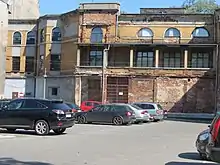Gliwice Theatre
Gliwice Theatre (Stadttheater Gleiwitz) was initially a private and later a municipal stage in Gliwice in Upper Silesia. It was opened in 1899 as part of the "Victoria" establishment, later it became one of the largest theatres in Upper Silesia as the city theatre. In ruins since 1945, the building remained unused for decades. Occasional events have been taking place in the ruins since the 1990s, and efforts are being made to rebuild it. The ruin is located at Aleja Przyjaźni 18 in downtown Gliwice.
.JPG.webp)
.JPG.webp)

History
The Victoria Theatre opened in 1899 as part of the Victoria Establishment, a large private cultural and entertainment centre with a hotel, restaurants and shops. The construction was carried out by Zimmermann and Wacha. The property belonged to Julius Leppich, who was also a partner in Victoria. Because the theatre was part of a building complex, it has not received any representative architecture and is located in a back courtyard, facing away from the main street Ulica Zwycięstwa (the former Wilhelmstrasse). In 1914 the city of Gleiwitz took over the theatre and contributed financially to the stage. The stage curtain was sewn by women from the "Beautiful Forest" who were known for their "beautiful forest embroidery".
In 1924, the theatre was redesigned. Also in 1924, the theatres in Gliwice, Hindenburg O.S. and Bytom were merged to form the "Oberschlesisches Theatre" (between 1924 and 1927 "Theater Dreier Städtische"). In addition, the "Upper Silesian Drama Theatre" was held in the building.
When the Red Army marched in on January 24, 1945, the interior of the theatre was set on fire and was never rebuilt. In the meantime, it was used as a warehouse. On the initiative of Ewa Strzelczyk (1961–1998), the director of the municipal cultural centre, the "Foundation for the Reconstruction of the City Theatre" was established in 1994. In 1996, the theatre was reopened for events, but the ruinous state was maintained. Since then it has been used for concerts, dance, theatre, musicals and film screenings. A well-known series of events is, for example, the "Jazz in Ruinach".[1][2]
Personalities
- Philipp Wenning, Artistic director and senior director 1936–1938[3]
- Johannes Schüler (1894–1966), 2. Kapellmeister 1920–1922[4]
- Therese Giehse, actress[5]
- Hannes R. Zinder, actor Upper Silesian Drama Theatre 1943–1944
References
- Silesian tourist information
- Grenzenlos: Zwischen den Zeiten
- Deutsches Theater-Lexikon
- Johannes Schüler
- Gunna Wendt: Erika und Therese: Erika Mann und Therese Giehse – Eine Liebe zwischen Kunst und Krieg, 2018
| Wikimedia Commons has media related to Stadttheaterruine Gliwice. |